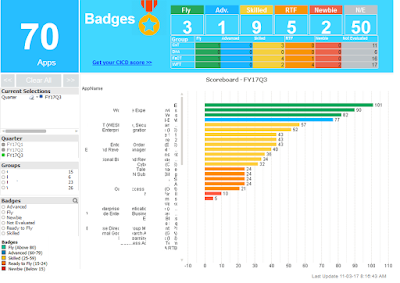
I have been having a great company with some of the very
talented NCG’s ( New College Hires/ Grads ) last ~2yrs. I work for
Intuit Inc. (India) and for the group
I work for , we have this great culture of putting our goals and
objectives into a tool called
BetterWorks.
What I love most about this tool is - it makes things
very transparent and gives you a picture about how the entire org is moving along in the desired direction , taking the right steps forward - to meet
the mission and vision of the organization in a very effective way.
Now with this background , let me set the context first. Last
week , while setting up the objectives for one of my NCG , I had
to help her setting up one personal development goal which is strongly encouraged at Intuit.
The goal I spontaneously suggested was : "Please see something around these C’s , or sign-up for some technical online or instructor led course of your interest"
The C's what I had in mind , and which eventually made a total of 8 C's are as below:
(1) Curiosity
The first thing , any individual , especially the new college grads
, should be fostering is - the element of 'curiosity'.
Curiosity means having the desire to learn new things. We must
ask questions and have an opinion. Try to be non-bias / non-judgmental and try
to look at things through fresh eyes. Research shows that - the
primary thing which contributes to non-curiosity is (a) Fear (b)
Disapprovals and (c) Absence of caring and guidance. My suggestion
here would be - exert yourself to read diverse kinds of readings, don’t take things as granted , and always keep an open mind.
(2) Creativity
Creativity is a struggle to go beyond what we were
yesterday. Creativity or innovation is the process of leaving the known and
venturing into the unknown. Being a new entry to the organization , you must first try to understand
and absorb things quickly and then also wear a customer lens to suggest process change or improvements ( if any) , apply automations or even suggest newer / smarter ways of doing things.
Creativity can transform any obstacle into
opportunity!
(3) Courage
At Intuit we strive to live
'these values'
every day – and the first one is ‘
Be Bold’ which encourages us to create
a vision that inspires and we always strive to think
beyond what is accepted as possible.
We
must always be willing to take a step forward no matter what...
(4) Competency
There is no short cut for learning , we have to upgrade our
knowledge on a daily basis. We must keep learning new things ; something new , day after day.
(5) Communication
Communication is the key, both verbal and written. While
there are myriads of tips and writings how to be a better communicator
, please don’t worry - communication is an art,
and nobody masters that overnight, at-least I haven’t yet! :))
One thing we must first try to focus on is – ensure we know how to articulate and we are understood.
(6) Connect
Connect to people and invest time on networking. This helps to understand industry trends , bouncing
ideas, solicit feedback or getting input,
formulate diverse perspectives , and
also learn from others. So please ensure
you have made at-least one professional connect every week , as you start walking into this new world ahead.
Professional networking is the
fuel that accelerates success!
(7) Conduct
Your behavior is everything. Don’t react, don’t push
rough shots and always have a ‘
Win Together’
mindset. Conduct is also about
Integrity – which will help you to win trust
, earn more responsibilities , gain respect , and build a brand / class which
is very important in this journey forward.
As it is said - its not about ‘what’ we do , but ‘how’ we do!
(8) Consistency
And finally , whatever we do , consistency in what we say
and what we do is very important , and it will have a multiplier effect -
to generate the trust on you as a
professional.
I personally believe that - these 8C’s will certainty generate lot of ‘awesomeness’ and ‘effectiveness’ in you and
will help you maintain the right ‘attitude’ all
the time.
If you are wondering , why the title is 8c,
well ,
-
it is
a mere co-incidence that the count came to 8 and I know for a reason that
- in Buddhism there is the concept of
Eightfold Path to achieve
Nirvana - the end of
suffering
:)
Also ‘c’ is one of the letter in English alphabet , which has maximum no. of
words in the dictionary and hence the higher probability of having a strong synonym / title for all the thoughts that I explained above.
Now is this a
SMART goal ? Well, yes.
The only thing is that – it does not have an ‘end date’ and it’s a journey!












